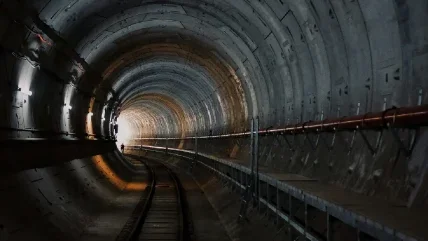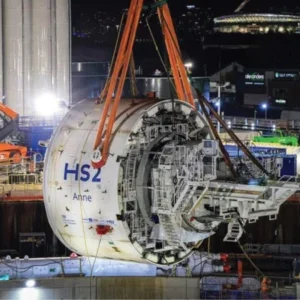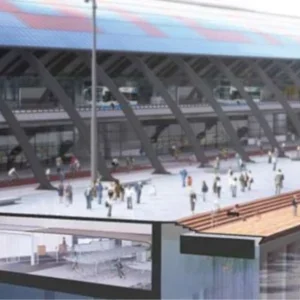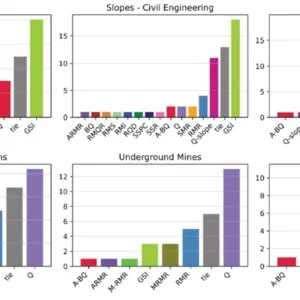
Perhaps the single achievement of John Bartlett’s career that is of most significance to tunnelling engineers is his invention of the bentonite tunnelling machine. It and its successor slurry and earth pressure balance machines have enabled mechanical tunnelling through non-cohesive gravelly or sandy soils to become economically possible; indeed now it is widespread. These machines are widely recognised as transformative technology. That, though, was just one of Bartlett’s tunnelling achievements. His work as designer of the UK half of the Channel Tunnel would be the tunnelling achievement that the non-specialist public would find most memorable. But appreciations of his life and work have also appeared in publications devoted to ships and the sea – his interest in, and knowledge of, maritime history was unrivalled. Had he chosen the law or music rather than engineering as careers (he pursued both to a high level), there also he could have excelled.
John Vernon Bartlett was born on 18 June 1927 in Wimbledon, London to Vernon Bartlett and his wife Olga (nee Testrup). It was an engineering family: his father was senior partner of Mott, Hay & Anderson, the firm John was later to head for 30 years. Indeed, it was John who negotiated the 1980 merger of the firm with Sir M MacDonald & Partners to form the current company Mott MacDonald.
Bartlett was educated at Stowe school and, after National Service with the 9th Airborne Squadron of the Royal Engineers, he read engineering at Trinity College, Cambridge. Typically, he did not limit himself to that one discipline. Most who have followed the engineering course at Cambridge have found it demanded all their studying time, but John combined it with reading law; he graduated with degrees in both. Not only that: he also acted and sang with the Footlights, the university’s drama society, to such effect that the D’Oyly Carte Opera company invited him to audition for them with a view to a life in musicals and light comic opera. He entered the spirit of the audition by turning up in the largest Mexican sombrero that he could find. He decided, however, perhaps narrowly, that civil engineering was his preferred future, but even after he joined John Mowlem in 1951, he continued to study for the bar exams which could have led to a legal career.
In 1957, he moved to his father’s company, the then small engineering consultancy of Mott, Hay and Anderson, where he was to spend the rest of his career. Tunnelling became a speciality. He worked on both tunnels of the Dartford Crossing; he was resident engineer on the first underground sections of the Toronto Subway; and he was project engineer for the Victoria Line, construction of which began in 1962.
That was the period which saw the genesis of the bentonite tunnelling machine. Tunnelling, by hand or by machine, through cohesive clay soils or through rock, was well-understood, but tunnelling through loose sandy or gravelly soils presented problems. Such soils were liable to collapse: the excavation and tunnel face needed continuous support, and water ingress was a constant danger. When it was attempted, the solution at that time was to excavate by hand in sealed chambers under compressed air. This was difficult. It was also highly dangerous to health: workers were prone to pressure-related conditions such as the ‘bends’, known to divers, and bone necrosis. Tunnelling through such soils was therefore problematic, costly, and sometimes impossible. This is the reason why London’s underground railway system at the time was very well-developed north of the Thames, in the London clay, but almost non-existent south of the river, where the soils are gravelly.
Milan also is built on soft gravel, but the city was constructing a metro line, nonetheless. In 1963, Bartlett was sent there to advise on a different project, but saw how work on the metro was being performed. It was a ‘cut and cover’ operation, and the engineers were creating near-vertical diaphragm walls by digging open trenches in the loose soil and filling them with a slurry of bentonite, which prevented the trenches from collapsing until concrete was poured in and displaced the slurry. Bentonite is thixotropic. In other words, it is a liquid when agitated, which means it can be pumped, but when not stressed it becomes a thick and viscous gel which supports the sides of the excavation thereby preventing collapse. It was Bartlett’s achievement to apply the concept of thixotropic slurries to a TBM.
Hence the bentonite tunnelling machine (BTM). Bartlett’s design had a cutting head that revolved within a sealed bulkhead filled with bentonite that was pumped in under pressure. The bentonite counterbalanced the pressure of the water in the ground and prevented it from flowing into the excavation; it also penetrated the face and circumference of the excavation, stabilising the soft soil and preventing it from collapsing. A useful additional benefit is that the slurry itself could be used to transport the excavated soil from the bulkhead through pipes to separation tanks on the ground surface. From there, the slurry is recirculated back to the pressurised bulkhead.
The machine was operated from behind the cutting-head bulkhead assembly, meaning that workers were under normal atmospheric pressure. A permanent lining of cast iron or concrete segments was installed behind the cutting head; the result was a fully-lined tunnel which had not exposed the tunnellers to the dangers of hyperbaric working.
In 1964, Mott, Hay and Anderson was awarded a British patent for Bartlett’s ‘Bentonite Tunnelling Process’. Development work meant that the prototype machine was not completed until 1971. It saw use on a short segment of tunnel for London Transport on a project, appropriately south of the Thames, to extend the Jubilee Line (or Fleet Line as it was then called) eastwards to Thamesmead. The machine was delivered to the site on 12 December 1971. Running from a hexagonal shaft that was 19.6m deep, the first drive took place on 24 February 1972.
The BTM performed as designed, but it was a time of national austerity and cut-backs and the Thamesmead extension was cancelled. So, the 144m stretch of successfully-built BTM tunnel, known then and now as the Bartlett Tunnel, was redundant and was sealed up, to remain unused.
Immediate UK take-up did not follow. The reduction in public spending of those years meant that only one infrastructure project suitable for the BTM was undertaken in Britain. It was a necessary if perhaps unglamorous sewer in Warrington. It was left to German and Japanese companies to further develop the slurry shield machine, and its direct descendant – the earth pressure balance TBM.
That these stem from Bartlett’s ingenuity and invention has been pointed out by Ivor Thomas, at the time Chair of the BTS, who says: “The company I work for, Bam Nuttall, is a sister company to Wayss & Freytag and I take great pleasure in pointing out the British history of the bentonite machine when my German colleagues have the temerity to mention ‘their’ invention. We have recently had three slurry machines in the ground. The drives would have been a lot harder, one could say probably impossible, with the old, compressed air techniques.”
In a letter congratulating Bartlett on being awarded the Sir Frank Whittle medal in 2018, Thomas wrote: “Your invention of the slurry machine and its subsequent development has made a tremendous difference to how and where we can tunnel. Slurry tunnelling has allowed us to develop tunnels in geology that would previously have been either very difficult and costly, or impossible. Much of the Jubilee Line to the south of the River, the Channel Tunnel Rail Link [CTRL] Crossing and the Crossrail River Crossing were only made possible by the use of slurry machines.”
History came close to repeating itself in Bartlett’s involvement with the Channel Tunnel. Mott Hay and Anderson were heavily involved in the scheme of the 1970s. Bartlett had design responsibility, first as a principal designer until the scheme was cancelled in 1975, leaving – as with the earlier London Transport project – a short section of completed tunnel on the UK side that remained sealed and unused for a decade. Happily, the section came into use following the project’s revival and revision in the 1980s, on which Bartlett was principal design consultant for all civil and geotechnical engineering for the UK section. As finally built, the Channel Tunnel project used three EPBMs on the French side, where the geology demanded them, but used double shield TBMs through the simpler geology for the excavations from the UK end.
Bartlett retired as chairman and senior partner from Mott Macdonald in 1988 but maintained his interest in the company and its activities to the end. It would be wrong not to mention another abiding passion of his: his unrivalled knowledge of ships and maritime history.
When he married his wife Gill in 1951, their first marital home was an old Medway pleasure craft called Demure, moored on the Thames at Putney. They later moved to a family house in Wimbledon, where they brought up four sons. “What you saw when you visited his house was little evidence of tunnelling – he was always modest about his achievements there – but a complete and absolute obsession with all things maritime” said one lifelong friend. “Everywhere you looked, from floor to ceiling and pretty much everywhere else, there were books on boats. His hobby was cataloguing all the ships in the world and he had this extraordinary memory: you could show him a picture of almost any boat or ship and he could tell you where it was built, who it was registered with, how many tonnes it could carry – details almost down to the colour of the walls in the officers’ mess.”
In 2003, he donated his library, of no fewer than 6,000 volumes, to the National Maritime Museum in Cornwall, which named its Bartlett Maritime Research Centre after him. Gill was reportedly pleased to have some space in the house.
Bartlett was a founder member and chair (1977-79) of the British Tunnelling Society; he won its James Clark Medal in 1994, and in 2018 was awarded the Sir Frank Whittle Medal of the Royal Academy of Engineering. He was President of the Institution of Civil Engineers in 1982-83. He was appointed CBE in 1976.
John Bartlett died on 17 November 2021, aged 94. His eldest son died a few days later.
Lord Robert Mair CBE FREng FRS, President of the Institution of Civil Engineers (2017-2018), said of him: “There can be no doubt that a major revolution in the worldwide tunnelling industry was triggered by John Bartlett’s invention of the bentonite tunnelling machine. It has enabled a rapid increase in tunnel construction around the world, particularly in urban areas, whether for water supply, sanitation and transport with remarkable benefit to humanity.”






